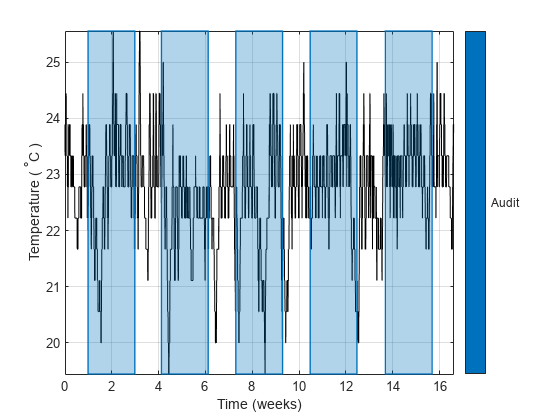extractsigroi
Extract signal regions of interest
Description
Examples
Consider a two-column matrix representing possible regions of interest of a 45-sample random signal. Extract the signal samples corresponding to the regions of interest.
x = randn(45,1); roilims = [5 10; 15 25; 30 35]; sigroi = extractsigroi(x,roilims);
Plot the signal and highlight the regions of interest.
plot(x) hold on for kj = 1:length(sigroi) plot(roilims(kj,1):roilims(kj,2),sigroi{kj}) end hold off

Consider a set of temperature data collected by a thermometer inside an office building for about four months. The device takes a reading every half hour. The sample rate is thus 48 measurements/day. Convert the temperature to degrees Celsius and plot the data.
load officetemp tempC = (temp-32)*5/9; fs = 48; t = (0:length(tempC) - 1)/fs; plot(t,tempC) xlabel('Time (days)') ylabel('Temperature ( {}^\circC )')

Create region-of-interest limits that separate the temperature data into 29-day periods.
roilims = [1 29; 30 58; 59 87; 88 116];
Extract the regions of interest. Compute the mean temperature of each period and display the values.
sigroi = extractsigroi(tempC,roilims*fs); cellfun(@mean,sigroi)'
ans = 1×4
22.8819 22.3073 22.7633 23.0066
Consider a two-column matrix representing possible regions of interest of a 45-sample random signal. Extract the signal samples corresponding to the regions of interest. Concatenate the samples into a single vector.
x = randn(45,1); roilims = [5 10; 15 25; 30 35]; sigroi = extractsigroi(x,roilims,true);
Plot the signal and highlight the regions of interest.
plot(x) y = NaN(size(x)); for kj = 1:size(roilims,1) roi = roilims(kj,1):roilims(kj,2); y(roi) = sigroi(1:length(roi)); sigroi(1:length(roi)) = []; end hold on plot(y) hold off

Consider a set of temperature data collected by a thermometer inside an office building for four months. The device takes a reading every half hour. The sample rate is thus 48 measurements/day. Convert the temperature to degrees Celsius.
load officetemp
tempC = (temp-32)*5/9;
fs = 48;Create region-of-interest (ROI) limits that correspond to five random two-week periods separated by at least 24 hours. Use the temperature readings from these days for an audit.
r = 5; w = 14*fs; s = 1*fs; hq = histcounts(randi(r+1,1,length(tempC)-r*w-(r-1)*s),(1:r+2)-1/2); t = (1 + (0:r-1)*(w+s) + cumsum(hq(1:r)))'; roilims = [t t+w-1];
Extract the regions of interest. Compute the mean temperature of each audited region of interest and display the values.
sigroi = extractsigroi(tempC,roilims); cellfun(@mean,sigroi)'
ans = 1×5
22.8075 22.2586 22.4256 22.9018 23.1457
Extract the regions of interest again, but now concatenate the samples into a single vector. Compute the mean temperature across the audited regions.
sigroic = extractsigroi(tempC,roilims,true); avgTFc = mean(sigroic)
avgTFc = 22.7078
Convert the ROI limits to a binary sequence and create a mask. Express time in weeks.
m = sigroi2binmask(roilims,length(tempC)); msk = signalMask(m,'SampleRate',fs*7,'Categories',"Audit");
Plot the data and visualize the regions of interest with rectangular patches.
plotsigroi(msk,tempC,true) xlabel('Time (weeks)') ylabel('Temperature ( {}^\circC )')

Input Arguments
Input signal, specified as a vector.
Example: chirp(0:1/1e3:1,25,1,50) specifies a chirp sampled at 1
kHz.
Data Types: single | double
Complex Number Support: Yes
Region-of-interest limits, specified as a two-column matrix of positive integers. The
ith row of roilims contains nondecreasing
indices corresponding to the beginning and end samples of the ith
region of interest of a signal.
Example: [5 8; 12 20; 18 25] specifies a two-column region-of-interest
matrix with three regions.
Data Types: single | double | int8 | int16 | int32 | int64 | uint8 | uint16 | uint32 | uint64
Option to concatenate extracted signal regions, specified as a logical value.
Data Types: logical
Output Arguments
Signal regions of interest, returned as a cell array or a vector.
Extended Capabilities
Usage notes and limitations:
If supplied, concat must be a constant.
Version History
Introduced in R2020b
See Also
Objects
Functions
MATLAB Command
You clicked a link that corresponds to this MATLAB command:
Run the command by entering it in the MATLAB Command Window. Web browsers do not support MATLAB commands.
웹사이트 선택
번역된 콘텐츠를 보고 지역별 이벤트와 혜택을 살펴보려면 웹사이트를 선택하십시오. 현재 계신 지역에 따라 다음 웹사이트를 권장합니다:
또한 다음 목록에서 웹사이트를 선택하실 수도 있습니다.
사이트 성능 최적화 방법
최고의 사이트 성능을 위해 중국 사이트(중국어 또는 영어)를 선택하십시오. 현재 계신 지역에서는 다른 국가의 MathWorks 사이트 방문이 최적화되지 않았습니다.
미주
- América Latina (Español)
- Canada (English)
- United States (English)
유럽
- Belgium (English)
- Denmark (English)
- Deutschland (Deutsch)
- España (Español)
- Finland (English)
- France (Français)
- Ireland (English)
- Italia (Italiano)
- Luxembourg (English)
- Netherlands (English)
- Norway (English)
- Österreich (Deutsch)
- Portugal (English)
- Sweden (English)
- Switzerland
- United Kingdom (English)